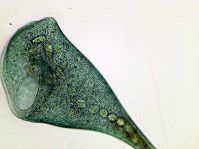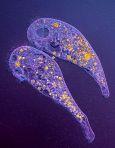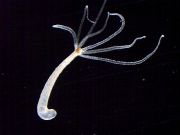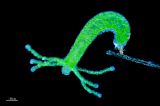|WEEK ONE|
4/11/2020
Introduction to the BIO Lab
I examined a puddle of mud sample and a soil sample collected the evening before, and a purple mold sample that was already in the lab. We saw microorganisms in the mud sample.
Glossary
- magnification: making images appear larger
- resolution: ability to distinguish between two objects
- slide: flat rectangles of thin glass which hold the sample under the microscope
- sample: something you collect to examine
- specimen: the sample on the slide when you look at it through the microscope
- cover slip/cover glass: a smaller and thinner sheet of glass that is placed over the specimen
- light microscope: it uses light in order to see an image
- electron microscope: it uses electron beams to see images (you can see a virus)
- compound microscope: it has two sets of lenses (eyepiece lenses - objective lenses)
- objective lenses: a set of lenses with different magnifications (e.g., 4x, 10x, 40x - 4 times: lowest magnification, 40 times: highest magnification)
- total magnification: is given from the multiplication between eyepiece lens magnification and objective lens magnification (e.g., 10x ocular and 4x objective > 40x total magnification).
- coarse focus and fine focus: two knobs which raise or lower the stage which helps with focusing.
- stage knobs: the move from side to side which helps exploring/scanning the specimen.
- mounting: securing the sample on the slide
- dry mount: a simple kind of mounting where the object is merely placed on the slide (this mounting can be successfully used for viewing specimens like pollen, feathers, hairs, etc.)
- wet mount: the specimen is placed in a drop of water or other liquid held between the slide and the cover slip. (this method is commonly used to view microscopic organisms that grow in pond water or other liquid media).
- disposable pipette
- stage clips: clips which secure the slide
- lens paper: the only paper you can use to wipe lenses
- staining: a technique used to enhance contrast in samples
- immersion oil: able to increase resolution (applicable if you have a 100x objective lens)
- fixation: it refers to the process of attaching cells to a slide; it is often achieved either by heating or chemically treating the specimen. It kills microorganisms in the specimen, stopping their movement and metabolism while preserving the integrity of their cellular components for observation
- simple staining: a single dye is used to emphasize particular structures in the specimen
- differential staining: more dyes are used to emphasize particular structures in the specimen
6/11/2020
Brogen and I collected different samples in the Ilm Park and examined them in the lab (spider web, tree bark, river water, mushroom spores, wet leaves). We found microorganisms moving in the river water and some little bugs both in the tree bark and in the spider web samples invisible to the naked eye. Mushroom spores were really interesting.
I examined again the mud samples: microorganisms were still there.
|WEEK TWO|
14/11/2020
Research: staining technique
Staining Microscopic Specimens Basic histological staining methods
Staining a technique we can take advantage of to enhance contrast and colour to the specimens; it is usally used to detect cellular structures or tissues, to distinguish characteristics you wouldn't see in a natural state.
Dyes are selected for staining depending on the chemical properties which determine how the dye will interact with the specimen. Dyes can be basic, acidic or a combination of the two. Acidic dyes carry a negative charge, so they bind to positively charged cells structure. On the other hand basic dyes carry a positive charge, so they bind to negatively charged cells structure.
A positive stain is a dye that will be absorbed by organisms, to make them stand out against the background (most commonly used). However, there are scenarios in which it is advantageous to use a negative stain, which is absorbed by the background but not by the cells or organisms in the specimen. Negative staining produces a silhouette of the organisms against a colourful background.
Commonly used basic dyes which serve as positive stains
- basic fuchsin
- crystal violet
- malachite green
- methylene blue
- safranin typically
Commonly used acidic dyes which serve as negative stains
- acid fuchsin
- eosin
- rose bengal
A simple stain will show all the organisms in a sample with the same colour, even if the sample contains more types of organisms. Differential staining, in contrast, distinguishes organisms based on their interactions with different stains, make them appear to be different colours.
Differential staining techniques commonly used
- Gram staining
- acid-fast staining
- endospore staining
- flagella staining
- capsule staining
15/11/2020
I would like to conduct some experiments related to the staining technique, and also find out how microorganisms react on stimuli.
|WEEK THREE|
17/11/2020
I am informing myself about some microorganisms and I found some interesting ones I would like to explore:
Stentor Protist
Stentor Protist: Reproduction, Anatomy & Habitat
They are shaped like little trumpets and they are made up of a single cell but some of them are large enough to be seen by naked eye. Usually found in ponds or lakes (freshwater environments). Interesting feature: they are remarkable for their regenerative power > when it is cut in half, each half is able to regenerate a half-sized cell that has its normal anatomy and will look the same way it did prior to being cut. There are green, blue and amethyst colored species.
Hydras
They are considered animals, predatory freshwaters microorgranisms; they can be found in ponds, lakek and other slow-moving waters. They feed on different creatures (e.g. insect larvae and small crustaceans) and they die only because of injuries, diseases, starvation or being eaten. Interesting feature: they can develop a mutualistic relationship with algae > the hydra feed on things that would otherwise predate on the algae, while the algae produce photosynthetic compounds that can be utilized as a food source by the hydra. ♥️
18/11/2020











